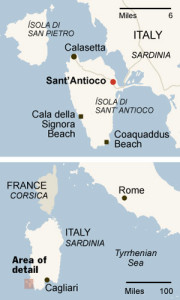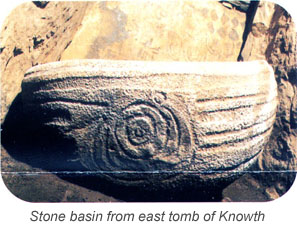muddy shoals
Sant’antioco Island
Sant’antioco Island is volcanic and situated at the south west coast of Sardinia and is the fourth largest  Italian island. There are shoals to be found around the island that have been suggestive for some(a) of the shoals created by the submergence of Atlantis.
Italian island. There are shoals to be found around the island that have been suggestive for some(a) of the shoals created by the submergence of Atlantis.
Luigi Usai specified the Sardinian region of Sulcis, which includes Sant’antioco, as the home of the Atlantean capital. The Phoenicians had an important city named Sulci on what is now Sant’antioco(c)!
Just north of Sant’antoco is the smaller island of San Pietro where Professor Giorgio Saba has identified two seastacks near Carloforte as the site of the Pillars of Heracles, known locally as the ‘ Faraglione Antiche Columns’.(b)
(a) See Archive 2898)
(b) https://www.costasmeralda.it/giorgio-saba-alla-ricerca-di-un-sito-mitologico/ *
(c) Sulci – Wikipedia *
Storegga *
Storegga submarine slides are enormous underwater movements of glacial  sedimentary deposits that were only recently identified. While many of these occurred following the melting of the glaciers at the end of the last Ice Age some more recent movements have also been identified(j)*. Either earthquakes or the decomposition of gas hydrates is their most likely cause. As many as three storegga have been identified that occurred off the west coast of Norway around 6000-5000 BC(a). The combined volume of material involved in the last two events has been calculated at 1700 cubic kilometres. As a consequence, gigantic tsunamis were generated which flooded a number of landmasses including Scotland.
sedimentary deposits that were only recently identified. While many of these occurred following the melting of the glaciers at the end of the last Ice Age some more recent movements have also been identified(j)*. Either earthquakes or the decomposition of gas hydrates is their most likely cause. As many as three storegga have been identified that occurred off the west coast of Norway around 6000-5000 BC(a). The combined volume of material involved in the last two events has been calculated at 1700 cubic kilometres. As a consequence, gigantic tsunamis were generated which flooded a number of landmasses including Scotland.
Ulf Erlingsson suggests that one of these events, around 6100 BC, may have been responsible for the final submergence of the Dogger Bank in the North Sea, creating the impassable muddy shoals mentioned by Plato. This idea, if you’ll forgive the pun, does not hold water, as Plato clearly says that the muddy shoals were still a maritime hazard nearly 6,000 years later when sea levels had risen considerably and could no longer present a navigational barrier.
The dating of these events is discussed by Bernhard Weninger and his associates in a 2008 paper available online(b).
Knut Rydgren and Stein Bondevik of Norway’s Sogn og Fjordane University have concluded that the flooding of Doggerland as a result of the Storegga event took place at the end of autumn(g).
The evidence to date suggests that the flooding of the Black Sea coincided with a storegga event, which would require a catastrophe on a scale not previously considered. In a 2017 paper(e), John M. Jensen offers additional evidence to support this contention.
In 2014, Dr Jon Hill revealed(d) the results of a study of the impact of the 6,200 BC Storegga on the low-lying Doggerland stating that “We were the first ever group to model the Storegga tsunami with Doggerland in place. Previous studies have used modern bathymetry (ocean depth).” The study was commented on further by Axel Bojanowski in Der Spiegel with an English translation on the de Grazia website(f). The scale of the landslide is graphically described there.
Yurii Mosenkis endorses this date proposing that it lay between 6225 BC and 6170 BC(h). Further support for the 6200 BC date can be read in a 2008 paper(i).
In 2015 the UK’s Daily Mail offered further details(c) gleaned from articles in the respected journals Geology and Science Nordic.
A paper published in 2020 by Alaister Dawson et al of Dundee University(l) refers to the studies in the Shetland Isles which indicate that the Storegga Slide tsunami run-up deposits have been identified between 8.1 and 11.8 metres above present sea levels. They add “It should be noted that the position of relative sea level ca 8 ka cited here as 20 m may have been as low as ca 30 m.” This suggests a tsunami of between 30 and 40 metres, which must have been a terrifying spectacle. This paper should be read in conjunction with an earlier paper(k) by Dawson.
(a) https://en.wikipedia.org/wiki/Storegga_Slide
(d) https://www.bbc.com/news/science-environment-27224243
(e) https://www.migration-diffusion.info/article.php?year=2017&id=505
(f) <tsunami submerged doggerland mesolithic paradise under north sea> (archive.org) *
(g) https://www.q-mag.org/moss-betrays-the-season-of-the-storegga-event.html
(j) shetland Tsunami hazards (archive.org)
(k) (PDF) The Storegga Slides: Evidence from eastern Scotland for a possible tsunami (researchgate.net)_
(l) https://discovery.dundee.ac.uk/ws/portalfiles/portal/38766820/Dawson_et_al_2019_Sedimentology.pdf
Erlingsson, Dr Ulf *
Dr Ulf Erlingsson is a Swedish geographer, geomorphologist and expert in underwater mapping. To explain several puzzles regarding the Ice Age, he developed The Captured Ice Shelf Hypothesis. He was the chairman of the Geographic Society of  Uppsala, Sweden and in 1991 he received the Linnaeus Prize from the Royal Society of Sciences in Uppsala.
Uppsala, Sweden and in 1991 he received the Linnaeus Prize from the Royal Society of Sciences in Uppsala.
Erlingsson was the American representative of AB Hydro consult(a), a spin-off from Uppsala University, Department of Physical Geography. A few years after moving to the U.S., he left AB Hydroconsult and founded Lindorm, Inc. in 2006, where he remains as CEO and President.
During the 1990s while studying the geography of the Baltic region, Erlingsson obtained a set of Soviet maps, which greatly assisted the building of the database he was engaged in. However, these maps, which had been bought openly in Riga, outlined plans for a Russian invasion of Sweden in the event of a war in Europe with NATO(b).
Since moving to Florida, Erlingsson has been very involved politically with the ‘Progressive’ wing of the Democratic Party.
Erlingsson recently identified the empire of Atlantis with the megalithic cultures of Western Europe and North Africa and suggested its capital may have been located in Ireland. His book [319] is interesting and contains a number of original ideas. However, as an Irishman, I am not convinced that our remarkable monuments in the Boyne Valley are the remains of or related to Atlantis. I will discuss this further in my review of his book. Erlingsson sees Atlantis everywhere, for example, in a carving on a stone basin found in the Knowth passage tomb close to Newgrange.
Erlingsson presented his ideas to the Atlantis Conference held on Milos in 2005(g).
Erlingsson has also suggested that the Irish authorities have deliberately made Newgrange inaccessible. This is total nonsense. As a frequent visitor to the site over many years, I have witnessed nothing but every effort being made to maximise the throughput of visitors into the very confined space within our most famous national monument. The carved basin (see image) discovered near Newgrange, is perceived by Erlingsson as a replica of Plato’s  circular city of Atlantis while I can see an early version of a Babylonian winged disk. In 2005, probably as a promotional ploy, he issued a challenge for an open debate on his theory.
circular city of Atlantis while I can see an early version of a Babylonian winged disk. In 2005, probably as a promotional ploy, he issued a challenge for an open debate on his theory.
Frank Joseph has related speculative ideas claiming that “the early date for New Grange, its circular construction, sophisticated solar orientation and mythic tradition all point to Atlantean origins.”[0636.70]
Like all ancient monuments, the Boyne Valley cluster has generated its own collection of wild speculation, such as Freddy Silva’s claim that there is a connection between Knowth and Sacsayhuaman near Cuzco in Peru and who also hints at a possible link with Egypt’s Osirion(f)!
Erlingsson has more recently suggested that the ‘sunken’ island referred to by Plato was probably located in the vicinity of the southern end of the North Sea. He proposes that around 6100 BC a tsunami generated by a massive storegga off Norway reduced the then low-lying Dogger Bank to the impassable muddy shoals recorded by Plato! He has suggested that the original Atlantis narrative, conveyed to Solon, was a mixture of an account of megalithic Ireland and a report of the inundation of Doggerland.
Dr Patrick Wallace, the Director of the National Museum of Ireland, declared that he was unaware of any archaeological evidence to support Erlingsson’s claims.
Nevertheless, Erlingsson has produced some interesting material on the bursting of glacial lakes or what is known in Iceland as jökulhlaups and their possible effect on the ending of the last Ice Age(c).
In 2020, the unaccredited Keystone University in Dublin published two articles on the Ancient Origins website, which drew on the theories of Erlingsson and supported the idea of Atlantis in Ireland(d)(e). The Keystone theory has been developed into a book[1775] by Anthony Woods.
(a) Wayback Machine (archive.org)
(b) USSR Planned to Invade Sweden (archive.org) (halfway down page)*
(c) Explanation of Bølling by jökulhlaup (archive.org)
(d) https://www.ancient-origins.net/unexplained-phenomena/atlantis-ireland-0013940
(e) https://www.ancient-origins.net/unexplained-phenomena/ireland-atlantis-0013941
